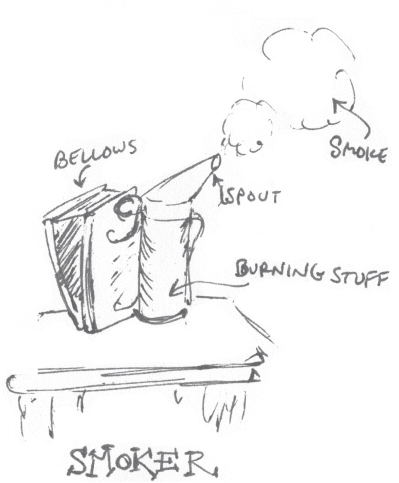The reason smokers look so delightfully old-fashioned
is that they are. Perfected by beekeeper
T.F. Bingham of Farwell, Michigan in 1875, they
really haven't changed much at all.

Eons ago, some cave dweller stumbled upon a new use for their relatively new invention of fire. It turns out that the smoke from it has a strange calming effect on bees when you're trying to steal their honey. Instead of trying to sting everything in sight, they crawl into their hives and start gorging themselves with honey.
Beekeepers still smoke their bees. They use a smoker, which is sort of a steampunk metal thing, roughly the size of a half gallon of milk, looking sort of like the Tin Man's oil can in The Wizard of Oz with a bellows attached to it from a tiny accordion sailors sometimes play in old movies. You light a fire inside from the top, which is hard to get going without getting your knuckle hairs singed, and add some reasonably natural fuel—dried paper pulp, pine needles, dry leaves, scraps of 100 percent cotton T-shirts—that will smoke nicely. The smoke emerges from a spout on the top when you close the lid and gently squeeze the bellows, which are small enough for one-handed operation.
The reason smokers look so delightfully old-fashioned
is that they are. Perfected by beekeeper
T.F. Bingham of Farwell, Michigan in 1875, they
really haven't changed much at all.

Why does smoke have that calming effect on bees? Three reasons. First, they are triggered to go into fire-drill mode, getting prepared to abandon the hive if necessary, which means they're distracted with stuffing themselves with food. Secondly, once they're stuffed with honey, it's hard to bend their abdomens enough to sting you even if they wanted to. Finally, the smoke masks their smell of fear and panic. Bees release alarm pheromones when under attack, but smoke masks the smell, short-circuiting any concerted defense of the hive. (Bees also leave a telltale chemical scent where they sting, creating a big bull's eye for other bees to aim at, which is why smart beekeepers quickly smoke any place a bee stings.)

Bees also leave a
telltale chemical scent
where they sting,
creating a big bull's
eye for other bees to
aim at . . .
